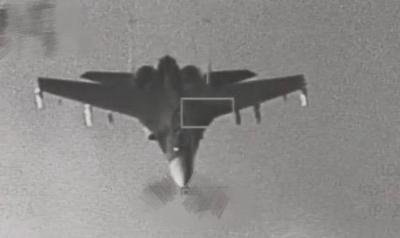The air force is no longer scrambling each time Chinese aircraft encroach on its air defense identification zone, but tracks the intruders with ground-based missiles instead to help save resources, a senior official said yesterday.
The air force has repeatedly scrambled to intercept Chinese jets in the past few months, and the US in July last year approved a possible US$620 million upgrade package for Patriot surface-to-air missiles to Taiwan.
Yesterday, 10 Chinese military aircraft, including fighter jets, entered the southwest corner of the zone, the Ministry of National Defense said, adding that it used missiles to “monitor” the incursion and its planes warned the Chinese aircraft over the radio.
Twenty Chinese military aircraft entered the zone on Friday last week, in the largest incursion yet reported by the ministry.
Although they have not flown over Taiwan itself, the flights have ramped up pressure, both financial and physical, on the air force to ensure its aircraft are ready to go at any moment in what security officials describe as a “war of attrition.”
Speaking at the legislature’s Foreign Affairs and National Defense Committee, Deputy Minister of National Defense Chang Che-ping (張哲平) said that initially fighter jets were sent out each time to intercept the Chinese aircraft, whose missions are concentrated in the southeastern part of the zone.
As that took up valuable time and resources, that strategy was changed, with Taiwan sending slower aircraft up if China did too, but that has also changed, Chang added.
“So we now largely use land-based missile forces to track them. We are considering the war of attrition issue,” he said.
The ministry has spoken of the repeated missions, along with its aircraft being “middle-aged,” leading to a huge increase in maintenance costs not originally budgeted for.

Trips for more than 100,000 international and domestic air travelers could be disrupted as China launches a military exercise around Taiwan today, Taiwan’s Civil Aviation Administration (CAA) said yesterday. The exercise could affect nearly 900 flights scheduled to enter the Taipei Flight Information Region (FIR) during the exercise window, it added. A notice issued by the Chinese Civil Aviation Administration showed there would be seven temporary zones around the Taiwan Strait which would be used for live-fire exercises, lasting from 8am to 6pm today. All aircraft are prohibited from entering during exercise, it says. Taipei FIR has 14 international air routes and

The Ministry of National Defense (MND) today released images of the military tracking China’s People's Liberation Army (PLA) movements during the latest round of Chinese drills around Taiwan. The PLA began "Justice Mission 2025" drills today, carrying out live-fire drills, simulated strikes on land and maritime targets, and exercises to blockade the nation's main ports. The exercises are to continue tomorrow, with the PLA announcing sea and air space restrictions for five zones around Taiwan for 10 hours starting from 8:30am. The ministry today released images showing a Chinese J-16 fighter jet tracked by a F-16V Block 20 jet and the

Snow fell on Yushan (Jade Mountain, 玉山) yesterday morning as a continental cold air mass sent temperatures below freezing on Taiwan’s tallest peak, the Central Weather Administration (CWA) said. Snowflakes were seen on Yushan’s north peak from 6:28am to 6:38am, but they did not fully cover the ground and no accumulation was recorded, the CWA said. As of 7:42am, the lowest temperature recorded across Taiwan was minus-5.5°C at Yushan’s Fengkou observatory and minus-4.7°C at the Yushan observatory, CWA data showed. On Hehuanshan (合歡山) in Nantou County, a low of 1.3°C was recorded at 6:39pm, when ice pellets fell at Songsyue Lodge (松雪樓), a

City buses in Taipei and New Taipei City, as well as the Taipei MRT, would on Saturday begin accepting QR code payments from five electronic payment providers, the Taipei Department of Transportation said yesterday. The new option would allow passengers to use the “transportation QR code” feature from EasyWallet, iPass Money, iCash Pay, Jkopay or PXPay Plus. Passengers should open their preferred electronic payment app, select the “transportation code” — not the regular payment code — unlock it, and scan the code at ticket readers or gates, General Planning Division Director-General Liu Kuo-chu (劉國著) said. People should move through the